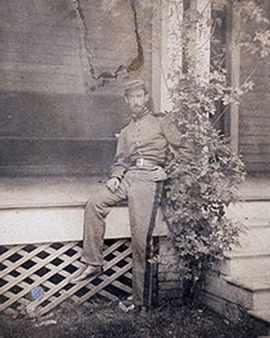Sanford Robinson Gifford succeeded like few others in capturing the atmosphere of the American landscape in his paintings. This is in contrast to the fact that he initially wanted to become a portrait painter and had himself trained in New York in human anatomy, among other things. But he soon realized that landscape painting was to become his true passion. Thus, along with other renowned artists such as Albert Bierstadt and Thomas Cole, he was a member of the Hudson River School, an art movement that drew primarily on European Romanticism.
Extensive travel marked Gifford's life. For two years, for example, he was in Europe; traveling from one city to another, he studied the art of European masters and was inspired by diverse sites to create new paintings, Italy in particular impressed him; several works depict Venice. Later his path led him to the Middle East, he visited Egypt, among other places, and found other places that he later put on canvas. Another important chapter of his life can also be found in his work: As a corporal, he took part in the War of Secession for the Confederate States and depicted this eventful time in some paintings, which stand out clearly from the idyllic landscape paintings. The bulk of Gifford's work, however, is made up of the landscapes of his native land, from the Rocky Mountains to the New Jersey coast. He took home numerous sketches from all over, and some became models for his paintings.
Like the other members of the Hudson River School - many of whom were his friends who accompanied him on some of his travels - Gifford depicted an idealized version of American nature. He focused on detailed depictions that he blended together to create an atmospheric whole. In doing so, his many paintings show the diversity of North American landscapes, and they indicate the painter's enthusiasm for the untouched, vast land. His preference for large expanses of water, which often fill a large part of the paintings and in which the horizon, the mountains and the forests are reflected, is also striking. Gifford was considered a very meticulous and perfectionist painter, often painting for whole days, from sunrise to sunset, not allowing anyone to disturb him. Then he would keep the painting with him for as long as possible, only to step back to the canvas weeks or even months later and add a few final brushstrokes. Only when it truly left no doubt under his critical gaze was it complete.
×





.jpg)
.jpg)
.jpg)
.jpg)
.jpg)
.jpg)
.jpg)
.jpg)
_-_(MeisterDrucke-1642722).jpg)
_-_(MeisterDrucke-1642722).jpg)
.jpg)
.jpg)
_1862_-_(MeisterDrucke-379563).jpg)
_1862_-_(MeisterDrucke-379563).jpg)
.jpg)
.jpg)
.jpg)
.jpg)
_Aug_28th_-_(MeisterDrucke-1495422).jpg)
_Aug_28th_-_(MeisterDrucke-1495422).jpg)
 1849 - (MeisterDrucke-277060).jpg)
 1849 - (MeisterDrucke-277060).jpg)
.jpg)
.jpg)
.jpg)
.jpg)
.jpg)
.jpg)
.jpg)
.jpg)
.jpg)
.jpg)
.jpg)
.jpg)
.jpg)
.jpg)
.jpg)
.jpg)
.jpg)
.jpg)
.jpg)
.jpg)
.jpg)
.jpg)
.jpg)
.jpg)
.jpg)
.jpg)
_-_(MeisterDrucke-1315467).jpg)
_-_(MeisterDrucke-1315467).jpg)
.jpg)
.jpg)
.jpg)
.jpg)
.jpg)
.jpg)
.jpg)
.jpg)
.jpg)
.jpg)
.jpg)
.jpg)
.jpg)
.jpg)
.jpg)
.jpg)
.jpg)
.jpg)
_-_(MeisterDrucke-1631298).jpg)
_-_(MeisterDrucke-1631298).jpg)
.jpg)
.jpg)
.jpg)
.jpg)
.jpg)
.jpg)
.jpg)
.jpg)
.jpg)
.jpg)
.jpg)
.jpg)
.jpg)
.jpg)
.jpg)
.jpg)
_-_(MeisterDrucke-1495435).jpg)
_-_(MeisterDrucke-1495435).jpg)
.jpg)
.jpg)
.jpg)
.jpg)
_-_(MeisterDrucke-1421830).jpg)
_-_(MeisterDrucke-1421830).jpg)
.jpg)
.jpg)
.jpg)
.jpg)
.jpg)
.jpg)
.jpg)
.jpg)
.jpg)
.jpg)
.jpg)
.jpg)
.jpg)
.jpg)
.jpg)
.jpg)
.jpg)
.jpg)
.jpg)
.jpg)
.jpg)
.jpg)
.jpg)
.jpg)
_-_(MeisterDrucke-1490273).jpg)
_-_(MeisterDrucke-1490273).jpg)
_-_(MeisterDrucke-1490271).jpg)
_-_(MeisterDrucke-1490271).jpg)
.jpg)
.jpg)
.jpg)
.jpg)
 - (MeisterDrucke-193544).jpg)
 - (MeisterDrucke-193544).jpg)
.jpg)
.jpg)
.jpg)
.jpg)
_About_40_leaves_and_covers_-_prote_-_(MeisterDrucke-1365935).jpg)
_About_40_leaves_and_covers_-_prote_-_(MeisterDrucke-1365935).jpg)
.jpg)
.jpg)
.jpg)
.jpg)
.jpg)
.jpg)
.jpg)
.jpg)
.jpg)
.jpg)
.jpg)
.jpg)
.jpg)
.jpg)
.jpg)
.jpg)
.jpg)
.jpg)
.jpg)
.jpg)
.jpg)
.jpg)
.jpg)
.jpg)
.jpg)
.jpg)
.jpg)
.jpg)
.jpg)
.jpg)
.jpg)
.jpg)
.jpg)
.jpg)
.jpg)
.jpg)
.jpg)
.jpg)
.jpg)
.jpg)
.jpg)
.jpg)
_-_(MeisterDrucke-911571).jpg)
_-_(MeisterDrucke-911571).jpg)
.jpg)
.jpg)
.jpg)
.jpg)
.jpg)
.jpg)
.jpg)
.jpg)
.jpg)
.jpg)
.jpg)
.jpg)
.jpg)
.jpg)
.jpg)
.jpg)
.jpg)
.jpg)
.jpg)
.jpg)
.jpg)
.jpg)






